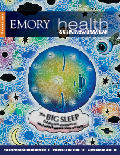The Era of AIDS
By James Curran
We are all part of the era of AIDS. My generation was the last to experience sex for the first time without fear of HIV. My children are part of the first generation to grow up with HIV. We now live in a different world because of a single infection that affects more than 33 million people.
Thirty years ago this summer, I led a CDC task force to study the first cases. They occurred in Los Angeles, where five healthy gay men had become ill with Pneumocystis carinii pneumonia (PCP). Within three weeks, we confirmed more than 25 additional cases of PCP in LA and New York City and several cases of Kaposi’s sarcoma (KS), a rare form of cancer, in NYC. These cases were significant. They were clustered among previously healthy gay men, they were fatal, and their cause was unknown.

James Curran served as director of the Division of HIV/AIDS at the CDC and was appointed assistant surgeon general of the United States. Dean of Emory’s Rollins School of Public Health since 1995, he recently received the Ryan White Distinguished Leadership Award, recognizing significant national contributions to AIDS. |
The first step in understanding this new epidemic was to develop a case definition and conduct intensive surveillance for cases of KS and opportunistic infections, which we later termed AIDS (acquired immune deficiency syndrome). Our definition was quickly adopted worldwide, allowing for precise and consistent identification of disease patterns in the United States and other countries with sophisticated health care.
A number of discoveries soon followed. Surveillance patterns confirmed the disease among gay men, intravenous drug users, and their sexual partners. We investigated three cases of PCP among men with severe hemophilia A and no other known risk factors who had received blood products pooled from thousands of donors. The identification of people with hemophilia provided solid epidemiologic evidence that a blood-borne and sexually transmitted pathogen caused AIDS.
Completing the picture, scientists confirmed that AIDS was likely caused by an unknown agent transmitted from mother to child and through heterosexual contact. The CDC took steps to protect health care workers and blood supplies and educate the public about transmission.
In 1983, French investigators from the Institut Pasteur identified HIV—the human immunodeficiency virus—as the virus that caused AIDS. The diagnostic test to detect HIV in the blood became available in 1984. Three years later, the U.S. Food and Drug Administration approved the use of AZT (azidothymidine), the first antiretroviral therapy (ART) drug to treat HIV.
In the 1990s, AZT proved beneficial in reducing mother-to-child transmission during pregnancy. The greatest breakthrough was the development of the AIDS cocktail or HAART (highly active antiretroviral therapy). Because of this combination therapy, people who were very ill could regain their health and resume their lives.
ART drugs were discovered by several scientists, mostly in this country. In the early 1990s, Emory researchers Dennis Liotta, Raymond Schinazi, and Woo-Baeg Choi developed FTC (Emtriva) and 3TC (Epivir), two of the major drugs now in use. Today, a single pill called Atripla, a combination of Emtriva and two additional drugs, replaces the handful of pills that men and women with AIDS took a decade ago.
Pockets of strength
In the early days, AIDS was very common in gay communities in San Francisco, New York, and Atlanta. At Emory, physician Sumner Thompson fought to open the Ponce de Leon Clinic at Grady Memorial Hospital to serve the growing number of Georgians with HIV. Today, the 8,000 patients treated annually by Emory clinicians at the Ponce Center, Emory University Hospital Midtown, and the Atlanta Veterans Affairs Medical Center comprise one of the largest concentrations of HIV/AIDS patients in the country. Research at these clinical facilities is part of the Emory Center for AIDS Research (CFAR), formed more than a decade ago to coalesce pockets of strength in basic, translational, behavioral, and epidemiologic research.
Prevention is CFAR’s central theme—health education, preventing transmission among adolescents and adults, developing and testing HIV vaccines, testing microbicides, and preventing and treating HIV and co-infections such as tuberculosis. Our work spans Atlanta, the Southeast, the United States, and Africa, Asia, and Eastern Europe. Currently, many studies are under way, including a phase 2 clinical trial for a leading HIV vaccine candidate, which was 96% effective when tested in rhesus macaque monkeys.
In 2010, Emory’s CFAR and the Global Vaccine HIV Enterprise hosted the international AIDS Vaccine Conference in Atlanta, and the mood among the 1,100 participants was upbeat. At the 2009 conference in Paris, researchers announced that a vaccine trial in Thailand yielded a 31% protection rate against HIV infection, the first positive result suggesting that research may produce a much needed and more effective vaccine. New discoveries presented in Atlanta showed that generating an immune response to neutralize different HIV strains might be feasible.
In the absence of a safe and affordable vaccine, prevention remains key. Each day, more than 7,000 people worldwide acquire HIV, totaling 2.7 million cases annually and including 56,000 cases in the United States. The rates of infection in sub-Saharan Africa continue to level off but remain at a very high rate. They are still rising in China and are a substantial problem in India, Eastern Europe, the Caribbean, and Latin America, where infection rates exceed available health resources.
In 2008, President Bush authorized five more years of funding for PEPFAR—the U.S. President’s Emergency Plan for AIDS Relief—to continue prevention, treatment, and health care training in more than 30 countries. As more people receive treatment and live longer, additional funding will be needed to sustain them.
Last year, President Obama introduced the National HIV/AIDS Strategy to intensify efforts to reduce disease incidence and health disparities in this country. The plan calls for targeting specific high-risk populations, re-introducing conventional prevention methods such as condom distribution and needle-exchange programs, and greater outreach to HIV providers in rural settings.
Research shows that preventing HIV is our best line of defense. When condoms are used consistently and correctly, they can reduce transmission by nearly 100%. Men who are circumcised have a substantially reduced risk of acquiring and transmitting HIV. A female microbicide recently tested in Africa reduced HIV transmission in that study by 40%. In Rwanda and Zambia, Emory scientist Susan Allen and colleagues showed that a large portion of the total number of HIV infections in these countries are transmitted within discordant couples (one infected, one not), who most often are unaware of their HIV status. The researchers have begun counseling and testing programs that have greatly reduced this transmission.
Today and 30 years from now, reducing HIV risk will pose some of the same challenges. Every year in the United States, more than 4 million people have sex for the first time. We must keep the conversation going about HIV/AIDS in homes, communities, and nations.
As one Emory public health researcher has said, “I don’t know of any other disease in modern history that requires people to talk so openly about their sexuality. We’ve got to talk about it, no matter how difficult.”
|
Web Connection: To learn more about Emory's efforts to prevent and cure AIDS, visit bit.ly/aids30emory. |



